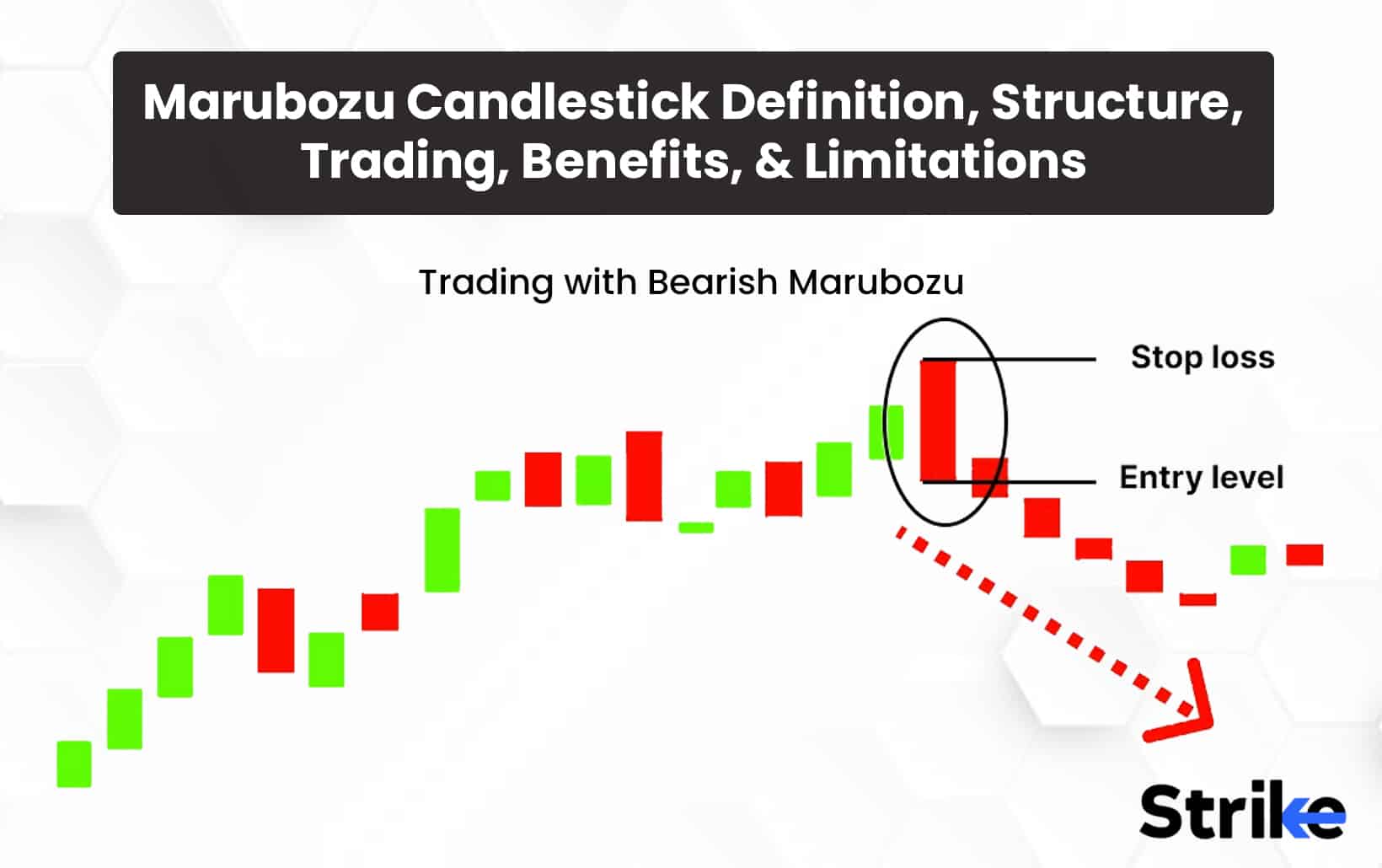
Marubozu is a non-shadow candlestick charting formation that occurs when the opening and closing prices of a stock are the same or very close to each other. Marubozu also occurs when the stock price does not trade outside the range of the opening and closing prices during the trading session. This pattern is significant in technical analysis as it is believed to indicate strong bullish or bearish sentiment in the market, depending on the color of the candlestick.
The invention of the Marubozu candlestick is often attributed to Munehisa Homma, a Japanese rice trader who lived from 1724 to 1803 and is considered the father of Japanese candlestick charting. Marubozu is a Japanese term that means “close-cropped,” and it refers to a candlestick that has a very small or no upper and lower shadow.
What is a Marubozu Candlestick?
The Marubozu is a candlestick pattern that shows the market’s determination to move primarily in one direction without encountering significant opposition from the other side. A Marubozu pattern often forces a conclusion at the high or low of the session.
The term Marubozu “close-cropped” or “shaved,” refers to the fact that the candlestick has no upper or lower shadow. A marubozu is a strong indication of a bullish or bearish trend, depending on whether it is a white or black candlestick.
Marubozu is a type of candlestick that has no wicks, meaning the high and low of the candle are the same as the open or close price.
A red marubozu occurs when the opening price is the highest point of the session, and the closing price is the lowest point of the session, indicating a strong bearish sentiment. Take a look at the below picture.

A green marubozu occurs when the opening price is the lowest point of the session, and the closing price is the highest point of the session, indicating a strong bullish sentiment.
You can see that the candle formed no wicks in both cases.
A Marubozo in an uptrend indicates that bulls are aggressively buying the asset and may continue upward. A bearish Marubozo in a downtrend (open equals high, low equals close) at the top of an uptrend indicates more selling pressure.
How is a Marubozu Candlestick Pattern created?
A marubozu candle is created in a price chart when the opening price of a stock is equal to the current low or the closing price is equal to the current high. A red marubozu candle is created when opening price and current low are equal. It is called a bearish marubozu.
A bullish marubozu is created when closing price is equal to the current high. Such a marubozu is green in colour.
A bullish Marubozu candlestick has no upper shadow and a long real body, indicating that buyers were in control for the entire session (or day). A bearish Marubozu candlestick has no lower shadow and a long real body, indicating that sellers dominated the trading session.
What is the importance of Marubozu Candlestick Patterns?
Traders and investors use Marubozu patterns to make trading decisions based on the strength of the current trend. A series of bullish Marubozu patterns indicate a strong uptrend. Uptrend is when the market is bullish. Investors and traders make use of an uptrend by buying stocks that are experiencing price momentum, with the expectation that prices will continue to rise. They can also use technical analysis to identify key support and resistance levels, trend lines, and other technical indicators to help them make informed trading decisions. They can use stop-loss orders to manage risk and protect their capital in case the trend reverses.
A series of bearish Marubozu patterns indicate a strong downtrend. Investors and traders can make use of a downtrend by employing various strategies to profit from the market’s decline. One approach is to short-sell stocks that are expected to drop. Another tactic is to use put options, which give the holder the right to sell a security at a predetermined price, to bet against the market. Investors can adjust their portfolios by reducing exposure to stocks and increasing holdings in assets that are less correlated with the stock market, such as bonds or commodities.
A Marubozu pattern appearing after a period of consolidation is a sign of a breakout or trend reversal as well.
What is the purpose of Marubozu Candlestick Patterns?
The purpose of marubozu patterns is to provide traders with a clear indication of strong bullish or bearish momentum in the market. A bullish marubozu indicates that buyers were in control from the opening bell to the closing bell, with no significant selling pressure during the day. Investors use uptrend strategies during this time period.
A bearish marubozu shows the sellers were in control throughout the trading day, with no significant buying pressure during the day. Investors and trades use downtrend strategies here.
Traders use marubozu to confirm trends, as well as to identify potential trend reversals. An uptrend has been established and a bullish marubozu appearing is seen as a confirmation that the trend is likely to continue. A bullish marubozu appearing is seen as a potential signal that the trend may be reversing.
When does the Marubozu Candlestick Pattern occur?
The Marubozthat occurs when a stock’s open, high, low, and close prices are all the same as the previous day’s closing price. This pattern occurs in both bullish and bearish markets and is characterized by a long body with little or no wick.
How often does the Marubozu Candlestick Pattern occur?
The occurrence of the Marubozu candlestick pattern depends on the time frame and the market conditions. The Marubozu pattern occurs frequently during a bullish period, indicating a strong trend. The Marubozu pattern is less common in a sideways or choppy market, as the price is not trending strongly in one direction.
What are the different Types of Marubozu Candlestick Patterns?
There are two types of marubozu candlesticks, mainly bearish and bullish marubozu candles. Both candlesticks reflect strong trends. Read below to read more about both.
1. Bearish Marubozu
A candle with an open equal to its high and a close equal to its low is known as a bearish marubozu. This demonstrates the complete dominance of sellers in the market. The stock is under such intense selling pressure that market participants are prepared to sell it at any time during the trading session. The stock’s price ended up close to its session low.
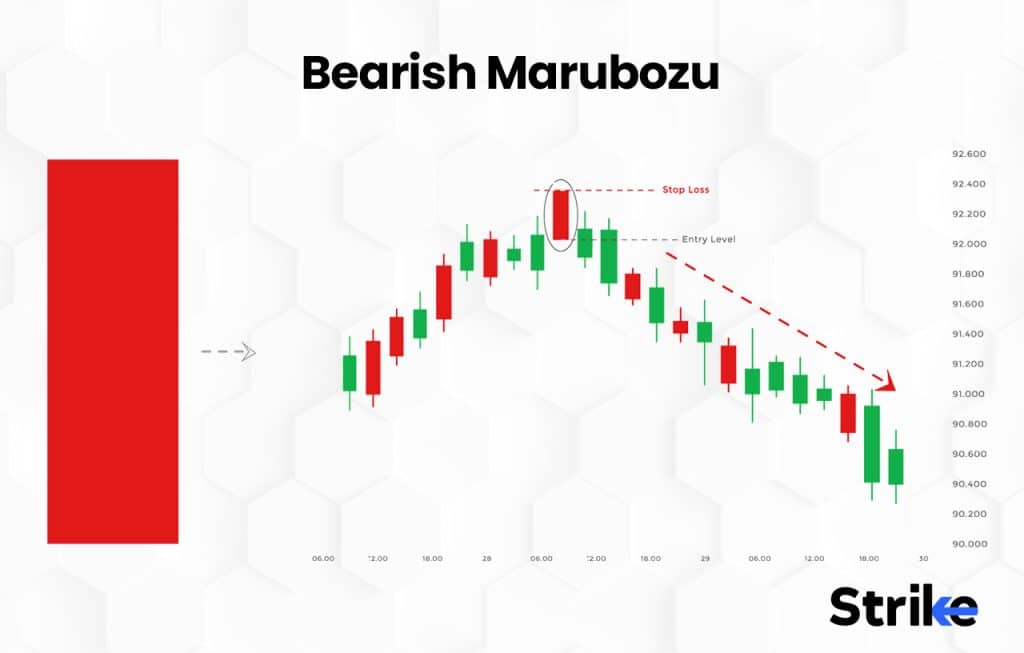
The trend will likely continue strongly when the bearish candlestick shows up during a downtrend, It functions as a trend reversal pattern if it does so during an uptrend indicating that the market sentiment has shifted and the stock is now bearish. It is anticipated that a surge in bearishness will follow this abrupt shift in sentiment and will last for the next few trading sessions. A trader should look for opportunities to sell after the occurrence of a bearish marubozu. The suggested selling price is just a little bit less than the marubozu’s closing price.
2. Bullish Marubozu
A bullish marubozu is presented with an absence of a lower and upper shadow. It means that the low price and the high price are both equal to the close price. A bullish marubozu is a candle that has an open value of low and a close value of high. This type of candlestick indicates that there is a lot of buying interest in the stock or that during that trading session, market participants are willing to pay any price to purchase the stock.
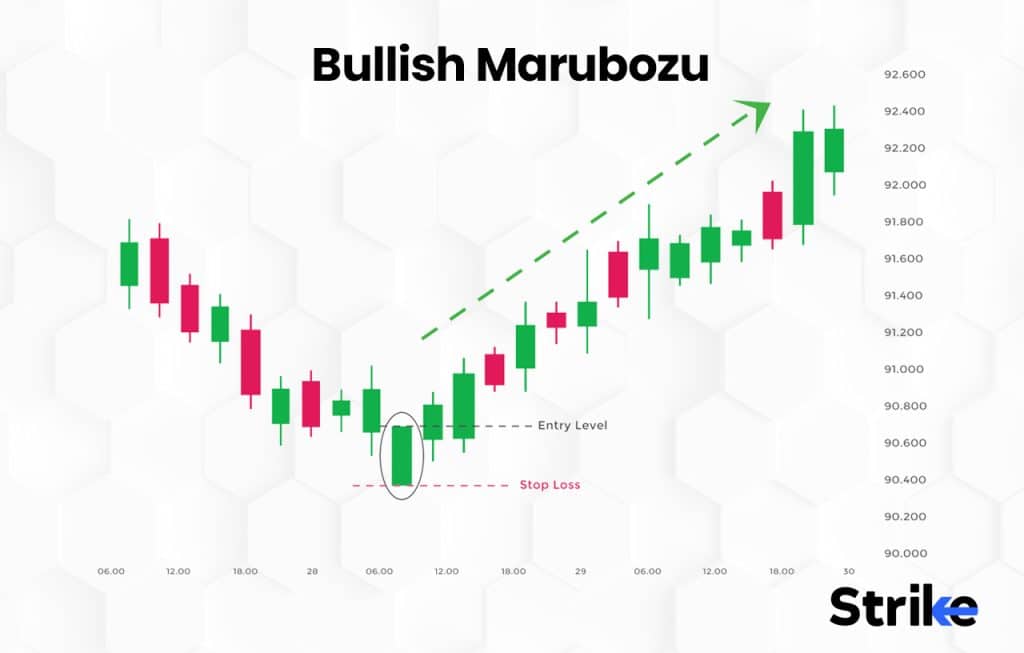
The stock’s price ended up close to its session high. A bullish marubozu is displayed during an uptrend strongly suggesting that the trend will continue. However, when it does, it signals a trend reversal, indicating that the market’s perception of the stock has changed and it is now bullish. A trader should therefore search for buying opportunities following the appearance of a bullish marubozu. It is suggested that the buy price is a little bit higher than the bullish marubozu’s closing price.
How to Identify Marubozu Candlestick Pattern in Technical Analysis?
A marubozu pattern is recognized easily because it consists of a single candlestick with a real body and no shadows of any kind. They typically appear white or green when bullish and red or black when bearish. The open price and close price in a bearish marubozu are both equal to the high price and low price, respectively. The open price corresponds to the low price and the close price to the high price when a marubozu is bullish. A flawless marubozu is uncommon in real-world market circumstances. A small difference between the open and close prices with the high and low price, typically less than 0.01 percent of the candle range, is disregarded when identifying a marubozu.
Is there a way to improve the accuracy of a Marubozu Candlestick Pattern?
Yes, traders can use four techniques to increase the accuracy of the Marubozu candlestick pattern.
Investors confirm the pattern with other technical indicators, such as moving averages, RSI, or MACD, to validate the trend and gain further insights. They look for volume confirmation, where high volume confirms the strength of the pattern and low volume suggests otherwise. They should consider the context in which the pattern occurs, as it provides a better understanding of the trend. Analyzing multiple timeframes provides a more comprehensive market picture and increases the likelihood that the pattern is a reliable signal.
How reliable is a Marubozu Candlestick Pattern in Technical Analysis?
Marubozu candlestick patterns are considered to be one of the most reliable candlestick patterns in technical analysis. The reliability of Marubozu patterns is attributed to the fact that they provide a clear indication of the market sentiment without any confusion. They are simple to look at and easy to comprehend The lack of shadows in the pattern indicates that there was very little price rejection during the trading session, which strengthens the sentiment further.
Marubozu is widely used by trades and they are available on almost all platforms which further increases its reliability.
But it is important to note that Marubozu patterns should not be analyzed in isolation. They should always be considered along with other technical indicators and chart patterns to confirm the market sentiment, similar to the case of any other tool related to the market.
What is the Success Rate of the Marubozu Candlestick Pattern?
The success rate of any candlestick pattern varies depending on market conditions, timeframes, and trading strategies. The Marubozu patterns are considered to have a success rate of 65-70% when used in conjunction with other technical indicators and price action analysis. But no trading strategy or indicator guarantee profits, and traders must always use proper risk management techniques and stick to their trading plan.
How to Trade with Marubozu Candlestick Pattern in Stock Market?
The first step to trade with marubozu pattern in stock market is identifying the type of marubozu.
A Bullish Marubozu candlestick pattern occurs when the opening price is the same as the low and the closing price is the same as the high. This pattern implies a strong uptrend and signals that buyers controlled the market from the opening bell to the closing bell.
Traders should attempt to enter a long position at the start of the next candle, with a stop loss below the Marubozu candle’s low. Technical indicators such as the Relative Strength Index and Moving Average Convergence Divergence is used by traders to validate the trend and suggest potential entry and exit locations.
A Bearish Marubozu candlestick pattern occurs when the beginning price is the same as the high and the closing price is the same as the low. This pattern indicates a significant downturn and signals that sellers controlled the market from the opening bell to the closing bell.
Traders attempt to enter a short position at the opening of the next candle, with a stop loss above the Marubozu candle’s high. Technical indicators such as the RSI and MACD can also be used by traders to validate the trend and indicate potential entry and exit points.
Investors usually look to buy low at this point in time.
What Happens After a Marubozu Candlestick Pattern?
Traders often check for confirmation of the trend after a Marubozu candlestick pattern before placing any trades. Other candlestick patterns or technical indicators, like as moving averages or trend lines, provide confirmation. Traders may also take into account the overall market conditions and news events that may have an impact on the stock’s price.
Traders may seek opportunities to enter a trade in the trend’s direction after confirmation. This could mean purchasing a stock with a bullish Marubozu or short-selling a stock with a bearish Marubozu. Stop-loss orders are also used by traders to protect their positions if the trend reverses.
What Indicator is Best to Combine with Marubozu Candlestick Pattern?
Using marubozu with other technical indicators provides traders with confirmation. Moving averages and the Relative Strength Index are the two most widely utilized indicators to pair with Marubozu.
Moving averages help you determine the trend and potential support and resistance levels. A trader uses a simple moving average (SMA) or an exponential moving average (EMA). The uptrend is confirmed if the Marubozu is bullish and the price is above the moving average. The downtrend is confirmed if the Marubozu is bearish and the price is below the moving average.
RSI is a momentum indicator that evaluates the strength of a trend. RSI validates overbought or oversold situations indicated by the candlestick pattern. Marubozu being bullish and the RSI being over 70 signals an overbought condition with the possibility of a reversal. A bearish Marubozu with an RSI below 30 suggests an oversold condition and a potential reversal.
What Indicator is Best to Combine with Marubozu Candlestick Pattern?
The moving average is a common indicator to use when combining the marubozu candlestick. The marubozu pattern suggests a strong trend, and the moving average confirms the direction and intensity of the trend. To identify short-term trends, traders frequently employ a simple or exponential moving average with a shorter time frame, such as 10 or 20 sessions. A moving average with a longer time range, such as 50 or 200 periods, is typically employed for long-term trends. You get more confidence in the market trend and make more informed trading decisions by combining the Marubozu pattern with a moving average.
Let us take an example. A trader is examining the stock price chart of Sun Pharma utilising candlestick patterns and moving averages. They notice that the stock has been constantly displaying bullish marubozu patterns in recent sessions, signalling a strong rally. But they want to confirm this trend and find the best entry and exit locations.
The trader add a moving average, such as the 20-period simple moving average, to the chart (SMA) here. Users see how the stock price interacts with the SMA, such as whether it is trading above or below the SMA and how distant it is from the SMA.A stock price continuously trades above the SMA validates the positive trend and gives the trader additional confidence to take a long position.
Is it effective to use Marubozu Candlestick with Moving Average Convergence Divergence (MA)?
Yes, the combination of marubozu candlestick patterns and moving averages convergence divergence (MACD) is a profitable trading method. Marubozu candles indicate a strong market trend, and when used in conjunction with the MACD indicator, traders pinpoint probable entry and exit locations. The MACD confirms the trend shown by the Marubozu candle, providing further confidence in the trade choice.
What is an example of a Marubozu Candlestick Pattern used in Trading?
A trader is analyzing Sun Pharma’s stock price chart and they notice a bullish Marubozu candlestick pattern in the chart. A bullish Marubozu candlestick pattern is characterized by a long green or white candlestick with no or very small shadows on both sides, indicating that the stock opened near its low price for the day and closed near its high price for the day. This pattern suggests a strong bullish trend in the stock.
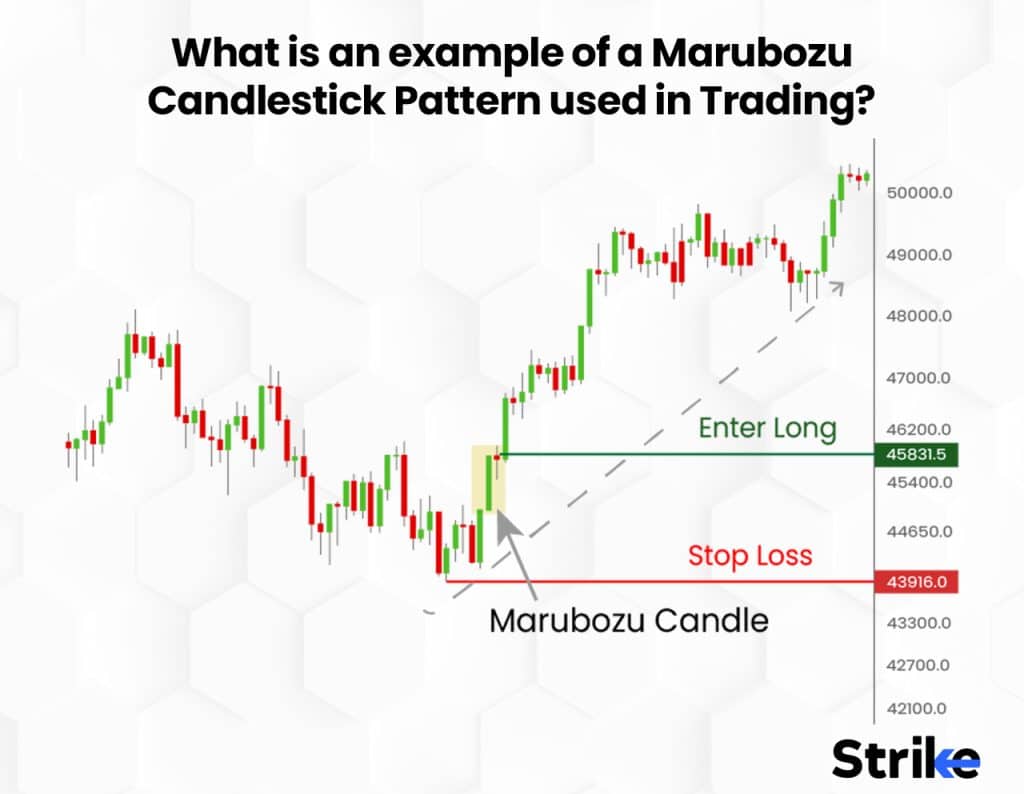
A trader consider entering a long position on Sun Pharma, as it indicates a strong bullish trend and a potential opportunity for profit.
A trader uses Marubozu candlestick patterns, such as the bullish marubozu, to identify potential trend reversals or continuations in a stock’s price chart and make more informed trading decisions.
Is Marubozu Candlestick Pattern profitable?
Yes, trading using marubozu candlestick pattern is profitable if used along with an indicator to confirm the trend. But it need not be always accurate, similar to the case of any indicator. Caution is hence suggested.
Is a Marubozu Candlestick Pattern a Bearish Reversal?
No, a Marubozu candlestick pattern sometimes indicate a potential reversal, but it is not necessarily always a bearish reversal. A bullish Marubozu appearing at the end of an uptrend signals a potential bearish reversal, and a bearish Marubozu appearing at the end of a downtrend signals a potential bullish reversal.
What are the benefits of a Marubozu Candlestick?
Marubozu candlestick patterns are commonly used due to their benefits. Below are four main benefits of using marubozu candlesticks for trading.
Marubozu gives a strong indication trend: Marubozu candlestick pattern indicates a strong trend in the market. A bullish Marubozu indicates a strong uptrend, while a bearish Marubozu indicates a strong downtrend. Traders easily identify trends because of how strongly marubozu suggests the trend.
Marubozu candlestick trends are clear: Since there are no wicks or shadows on either end of the Marubozu candlestick, there is no confusion about the opening or closing price of the security. This makes it easier for traders to decide on their moves.
Marubozu is easy to stop: Marubozu candlestick pattern is easy to identify and interpret. It is a single candlestick pattern, and traders easily spot it on the chart. This fact makes marubozu easily identifiable even for beginners.
Marubozu patterns are comparatively reliable: The Marubozu candlestick pattern is a dependable price action indicator. It provides traders with a clear indicator of the trend’s direction and market’s strength.
The above advantages are best utilised when traders use a technical indicator to confirm the trend as well.
What are the limitations of a Marubozu Candlestick?
Marubozu patterns come with three main disadvantages, especially due to the lack of information each candle provides. Below listed are the three main disadvantages.
Lack of information: Marubozu candles only provide information on the opening and closing prices of the day. This results in a significant lack of information. It does not offer any information regarding the highest or lowest point of the day. This makes it difficult for traders to make judgments that are in their best interests.
Marubozu has limited usage: Marubozu candles have a limited range of applications because they are not ideal for all types of market situations. They are most effective in markets that are characterized by clear and persistent patterns; but, in markets that are volatile or range-bound, they will not offer any informative insights at all
Marubozu are sometimes overused: Traders who rely on Marubozu candles an excessive amount run the risk of missing out on other crucial indications in the market. It is essential to make use of a variety of chart patterns and indicators in order to make educated decisions about trading. Marubozu is commonly used even with the above disadvantages. These advantages are avoided when not overused and used in conjunction with other indicators like MACD.
What are other Types of Candlestick besides Marubozu?
There are more than hundreds of candlestick patterns besides marubozu . Read on to find out more about five of them.
Bullish hammer: A bullish hammer is a type of candlestick pattern that indicates a reversal of a bearish trend. Bullish hammer pattern is presented as a single candle and is presented as an H. The formation of these candlesticks suggests that there is a possibility of an uptrend developing in the market. A bullish candlestick pattern is a useful tool because it helps investors to enter a long position in order to capitalise on the suggested upward movement,
Engulfing patterns: The Engulfing pattern is a type of reversal pattern that indicates a significant shift in the market’s overall trend. There are two engulfing patterns – bullish and bearish. Two candlesticks are required to complete the Engulfing pattern. The initial candle will move in the same direction as the trend that came before it. The first candle in the pattern will have a red colour when a Bullish Engulfing pattern is formed. Then the second candle will hit a new low, but it will still end its trading session higher than where it opened, effectively swallowing the first candle whole. The inverse is true for a bearish engulfing, which consists of two candles, the first of which has a small green body and the second of which has a massive red body that completely engulfs the body of the first candle. This pattern indicates that bearish sentiment will prevail in the market.
Dark cloud cover: The dark cloud cover candlestick pattern shows a bearish turn because it looks like a dark cloud is covering the optimism from the day before. It is made up of two candlesticks. The first one is red and starts above the green one that comes before it and ends below the middle of the green one. It is a sign that the bears have taken control of the session, which has resulted in a sharp decline in price. Short wick candles indicate that the downward trend was very clear-cut and unambiguous.
The Three Outside Down: The Three Outside Down is a pattern made up of several candlesticks that shows a change from going up to going down. This pattern is named for its three outside candles. It is made up of three candlesticks, with the first being a small bullish candle, the second being a large bearish candle, and the third being a neutral candlestick that should cover the first candlestick. It is recommended that the third candlestick be a long bearish candlestick that confirms the reversal to a bearish trend. The pattern of the Bearish Engulfing candlestick should be present between the first and second candlesticks in the relationship between them. Traders have the opportunity to enter a short position after the completion of this candlestick pattern.
The evening star: The evening star is the bearish counterpart to the more popular morning star pattern. It takes the shape of a small candle that is situated between a tall green candle and a large candlestick that is coloured red. It is a sign that an uptrend is about to reverse, and it is especially powerful when the third candlestick wipes out the gains made by the first candle in the sequence.
There are hundreds of candlestick patterns other than marubozu that traders can use to identify potential shifts in the market’s direction, including Bullish Hammer, Engulfing Patterns, Dark Cloud Cover, Three Outside Down, and Evening Star. Each of these types of candlesticks provides valuable information about potential trend changes and assist traders in making more informed trading decisions.
Is Marubozu Similar to Bearish Engulfing?
No, marubozu and Bearish Engulfing are two different candlestick patterns in technical analysis. A Marubozu is a single candlestick pattern that has a long body with little to no wicks or shadows at the top and bottom. It indicates a strong trend in either direction, depending on whether it is bullish or bearish. A Bearish Engulfing pattern is a two-candlestick pattern where the first candlestick is bullish, and the second candlestick is bearish and engulfs the first candlestick. It indicates a reversal of the previous bullish trend and the beginning of a new bearish trend.
What is the difference between a Marubozu Candlestick and a Piercing Line Candlestick?
Marubozu candlestick is distinguished by the absence of an upper or lower shadow. It denotes the presence of a significant trend in the market, which may be bullish or bearish, with buyers or sellers in control throughout the entirety of the trading session. A Piercing Line candlestick consists of two candlesticks and is known as a piercing line. The first candle is a red candlestick that opens below the low of the previous candle and closes more than halfway above the body of the previous candle. The second candle is a green candlestick that opens below the low of the previous candle and then closes more than halfway above the body of the previous candle. This pattern points to the possibility of a trend reversal occurring in a downward movement.


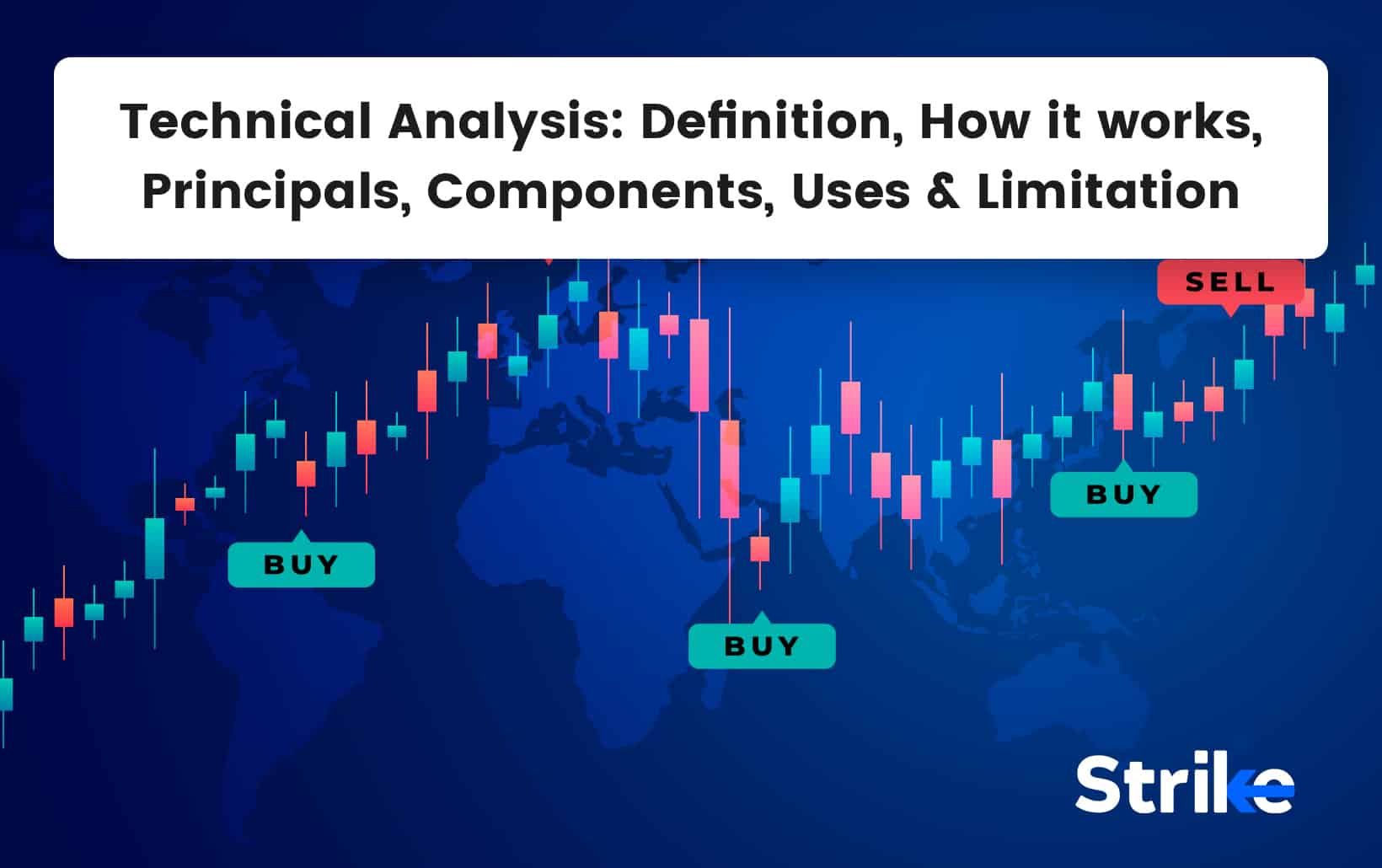

![85 Common Stock Market Terminologies for Dummies [Updated List for 2025] 46 85 Common Stock Market Terminologies for Dummies [Updated List for 2025]](https://www.strike.money/wp-content/uploads/2025/04/Popular-Stock-Market-Terms-for-Beginners-Banner.png)





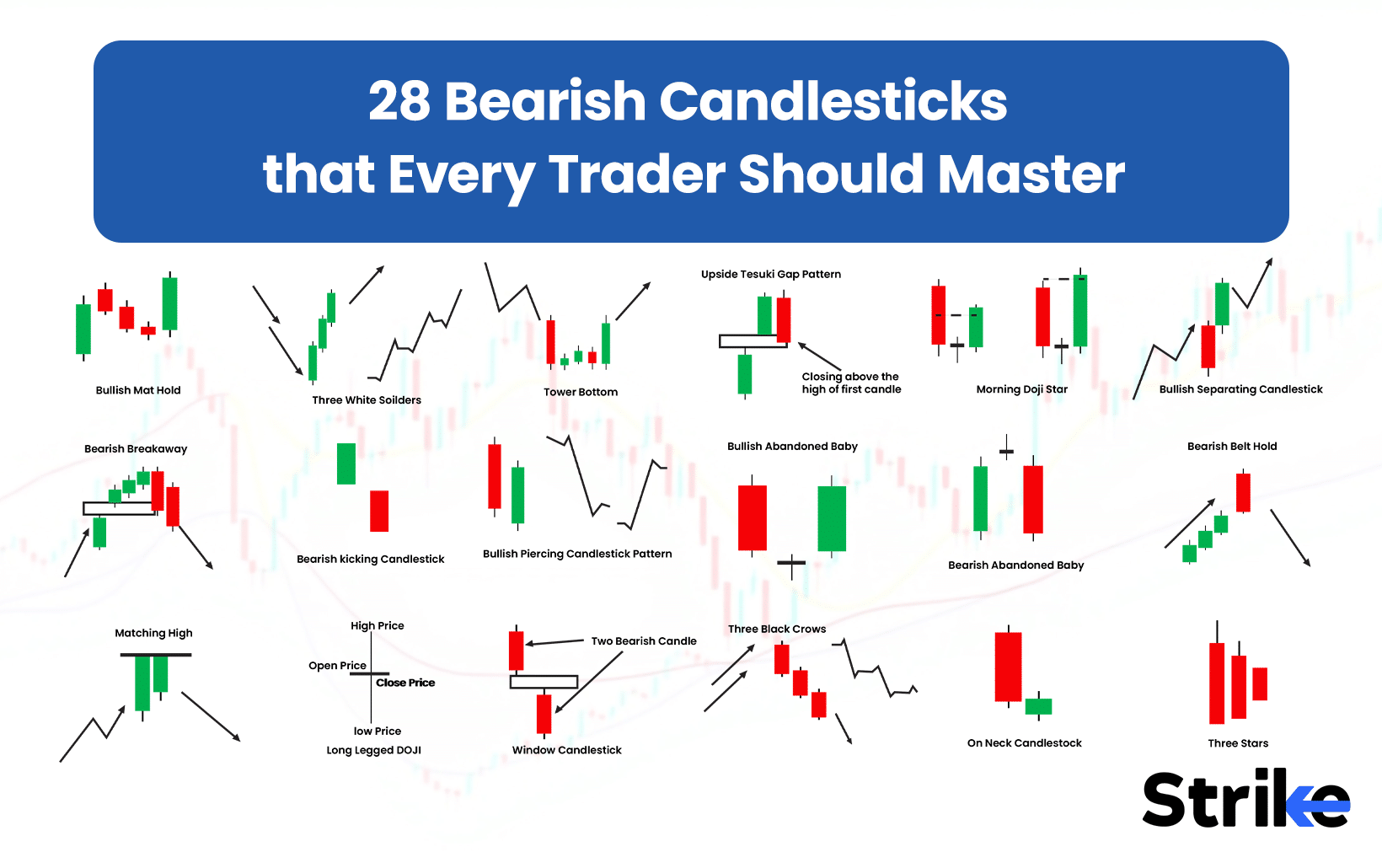





No Comments Yet.